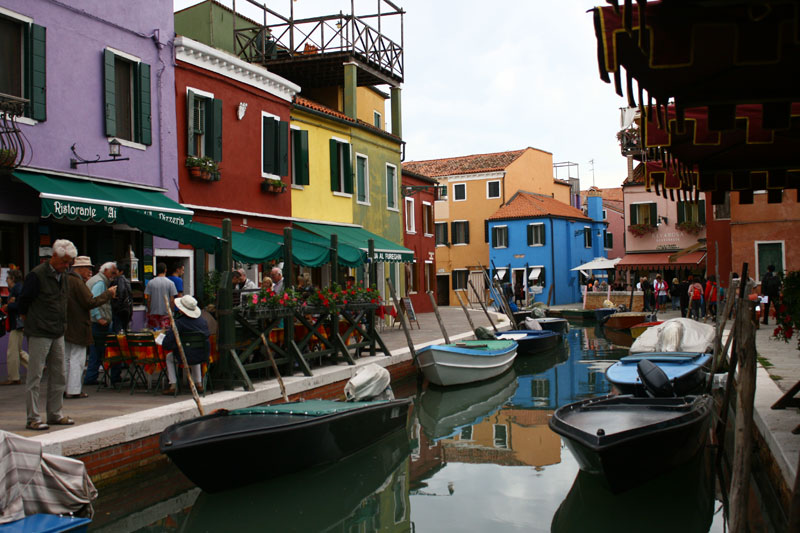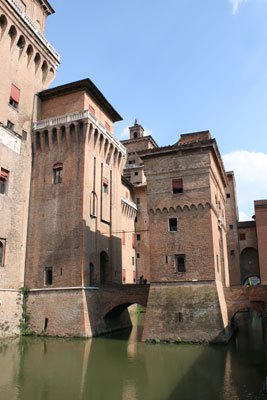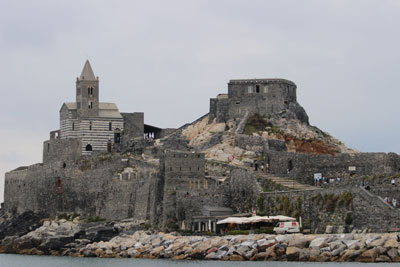Discovering three special places on an exploration of Italy
This article appears on page 36 of the April 2014 issue.
by Joyce Bruck; Ocean Ridge, FL
The first stop my cousin June and I made on our September ’13 trip was selected because of a recommendation in Frommer’s “Italy Day by Day,” which listed Ferrara, Italy, among its “Favorite Small Cities and Towns” and mentioned the Locanda Borgonuovo (via Cairoli 29), where we stayed, on its “Favorite Small Inns” list.
Ferrara
Ferrara, a UNESCO World Heritage Site, is an easily walkable town surrounded by still-intact ancient walls. The traditional main piazza has a cathedral and a watchtower at its center.
The locanda (inn) is accessible from the Bologna airport by bus, which stopped about two blocks from the hotel, for €15 ($20), or by train from Bologna or Venice.
It offers different kinds of rooms and suites, some with kitchens. Rooms in the main house cost from €85 to €95 ($116-$130) per night, including a delicious breakfast of bread, coffee or tea, ham, cheese and fruit served in the charming dining area. Bicycles are available for guests’ use. (Most of the locals use bicycles to get around.)
Our accommodations were very close to the main attraction of the town, Castello Estense, built as a fortress in 1385 and later transformed into a lordly residence. The castle tour we took allowed us to wander into the dungeons as well as other rooms in the castle.
Upon the excellent advice of the innkeeper, we each bought a MyFE tourist card at the castle, giving us free entry into most of the city’s museums, many of which were not very far away from our B&B. The cost of a 2-day card is €10; a 3-day card (€12) and 6-day card (€18) are also available.
To get a 10% discount for the bus transfer from the airport to Ferrara, you can purchase a MyFE card online before arriving.
On the town
The first night there, June and I ate at Leon d’Oro, located directly on the main piazza with a view of the 12th-century Duomo. The locals sipped cocktails and munched appetizers on the patio for hours. In most restaurants, dinner is not served until about 8 p.m., which is long past my usual mealtime.
It took us a while to decide what to get. I finally opted for the specialty of the area dating back to the Renaissance, cappellacci di zucca (€9), a thin egg pasta filled with soft pumpkin, Parmesan cheese and nutmeg served with a white sauce. We found the food in Italy good but expensive — and even more so in Venice.
On another night we had a good meal in the ancient Jewish ghetto, established in 1627 when the Este family departed Ferrara. Wandering along the picturesque medieval streets of that area, we came upon a square with plaques dedicated to the Jews who died at the hands of the Nazis. Nearby, Orthodox Jews were observing a holiday in the synagogue. The men, with long curls, were dressed in the typical black attire, including hats and knee-length coats.
For the next two days we walked around Ferrara visiting the various museums, mostly housed in 15th-century palaces. My favorite exhibition, located in the Museo Archeologico Nazionale, displayed Etruscan pottery.
Among the other interesting museums were the Palazzo dei Diamanti, clad with 8,500 pyramid-shaped marble blocks, the Casa Romei, an elegant villa that was among my favorites because it had period furnishings, and Palazzo Schifanoia, featuring lovely 15th-century frescoes.
On to Venice
When we were ready to move on to Venice, the departure point for a 9-day cruise I had booked, the innkeeper called a taxi for the 10-minute ride to the train station. We arrived just in time to buy our tickets and get to the platform.
The only problem was that, as in most train stations in Italy, there was no elevator, so we had to take the stairs down, go under the tracks and come up the stairs on the other side. I had a heavy suitcase with special clothes for the cruise plus my camera equipment, which made climbing the stairs difficult. Thanks to my cousin’s assistance, we made the train with a few minutes to spare.
Upon arrival at the train station in Venice, I went to the automatic dispensing machine to get our tickets for the vaporetto, which I had reserved in advance on the Internet. My ticket, good for 72 hours (€35), didn’t include transportation on the lagoon boats, so I had to buy a 12-euro day ticket to visit the lagoon islands.
June and I stayed in the Santa Croce sector of Venice for three nights before the cruise began. During that time, we resided at Hotel Al Sole (Santa Croce 134/136), a 15-minute walk from the train station and not far from the docks.
There was one bridge on the way to the hotel that was difficult for me to traverse with my luggage, so I allowed one of the boys hanging around to help, hoping he wouldn’t run away with my bags (which he did not).
I booked the hotel stay well in advance of our visit, so I was able to get a large room with two beds that overlooked a picturesque gondola station on a small canal for a reasonable price (€615, or $845, including VAT, for three nights). The included breakfast was good, and the staff was very helpful in giving directions and making dinner reservations.
City sights
The first view of the expanse of the Grand Canal was breathtaking. When seeing so many places that were so beautiful and well preserved, it was hard to decide where to look first and what to photograph. We had several choices for getting around Venice by boat: the usual vaporetto; the traghetto (used for crossing a canal where there is no bridge), which cost about €2, but passengers usually have to stand in the boat, and the expensive, more private water taxi.
I spent one of our four mornings in Venice visiting an island in the lagoon, which I reached by vaporetto No. 12 leaving from Fondamenta Nuove. My selection, Burano, known for its colorful buildings painted so they can be spotted from boats at sea, was magnificent! It has been inhabited primarily by lacemakers and fishermen since the 15th century.
During the two hours I was there I roamed the streets, walking through Piazza Galuppi and along the canals, crossing small bridges and taking many photographs along the way.
There were restaurants along the canals in which to stop for lunch, but I found a small cart selling crepes for about €2. It was quick, and I could people-watch while I ate, sitting on a boulder.
Some of the other islands of interest are Murano, known for its glassblowers, Torcello, the location of an old church and mosaics, and San Michele, the city cemetery.
Although Burano was a little touristy, it was possible to roam in the secluded areas to observe daily life and see the small fishing boats. Make sure you have your camera!
Cinque Terre
The third special place I discovered on this trip was the final stop on my cruise. Frommer lists the Cinque Terre as one of the most scenic places in Italy. It is composed of five multicolored villages — Riomaggiore, Manarola, Monterosso al Mare, Corniglia and Vernazza — perched on the edge of the mountains. The villages were once connected by walking trails, some easy and some difficult, but the area has not yet recovered from landslides caused by flash flooding in 2011, so not all hiking paths had reopened.
My ship docked at Porto Venere for the day, and I had decided that I would rather spend the time on my own instead of taking a tour. Upon arriving, I inquired about the schedule for the ferry/sightseeing boat that made various stops at the villages along the coast. With the 24-euro weekday ticket, I could disembark and reboard at any of the stops.
The village of Vernazza, with a church and a castle tower, was my favorite. After roaming around the village and taking photos, I reboarded the ferry for the next stop, where I spent some time.
At the third stop, however, it was too difficult for me to climb up from the boat to the village high above. After walking a little of the way, I went back to the dock and caught the next ferry back to the location where my ship was docked.
There are hotels and restaurants in each village for those who want to spend more time.
The Cinque Terre also can be reached from La Spezia by ferry or train. A discounted one-day train ticket can be obtained for €8 by anyone over 70. There are also private tours available from Florence.
Google “Consorzio Marittimo dei Poeti” for the ferry schedule, as it changes with the seasons.



